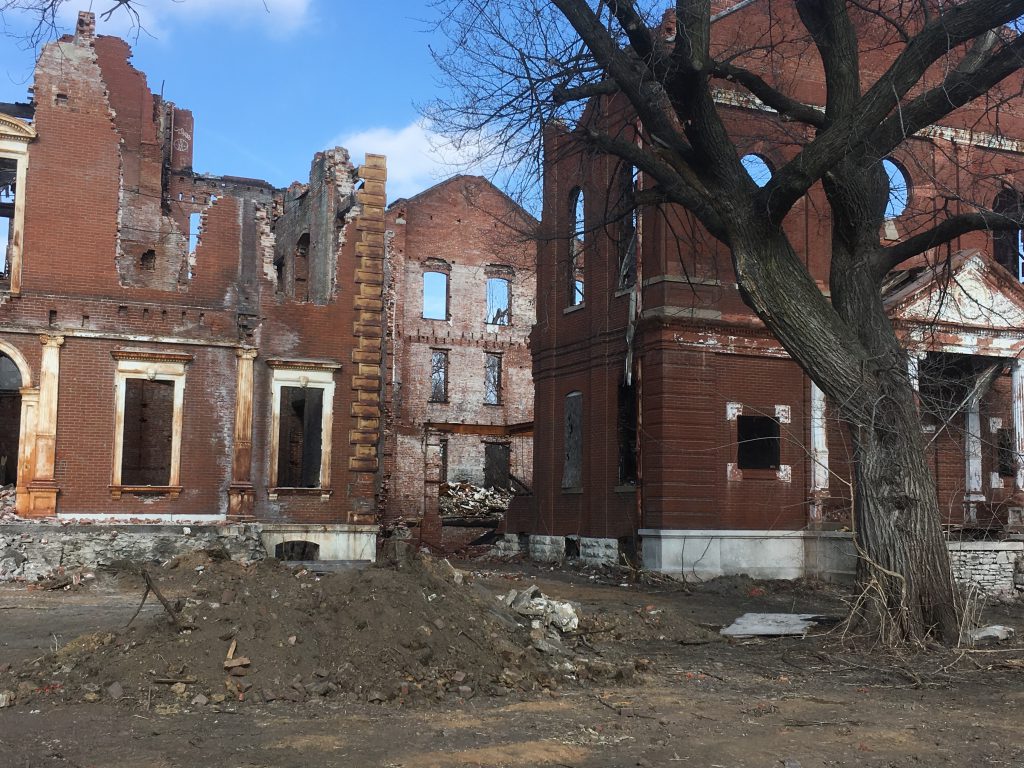
By now, the final pallets of bricks are leaving the site where the city’s only pre-Civil War mansion to await rescue, the James Clemens House, once stood. After a fire last summer, the house seemed pretty certainly headed for its dirt nap. Yet just eight years ago, the forlorn landmark was the backdrop for the ceremonial signing of Paul McKee’s Northside Regeneration redevelopment agreement.
Mayor Francis Slay, Alderman Freeman Bosley Sr. (D-3rd) and other elected officials lauded McKee in front of the Clemens House, while McKee promised that the house would become the new image of hope for north city. At that time, McKee promised $8 billion in redevelopment for the near north side of the city.
Eight years later, the symbol of hope is another dour record of demolition by neglect. There’s no longer much to learn in the dingy mess of dust and brick fragments where once our city’s political elite proclaimed – with no apparent irony at the time — hope.
It turns out that the Clemens House wreckage teaches us one more thing, even at death: For the last ten years, as the Clemens House continued to deteriorate, and remain in a condition violating city ordinances, its owner never faced the barrage of fines that would hit any average citizen leaving a building to rot. As a developer with approved redevelopment rights, McKee was except from complying with the city’s vacant building registration ordinance.
In 2010, then Alderwoman Kacie Starr Triplett (D-6th) introduced for a second time a bill to create a vacant building registration with an initial registration fee and an annual penalty of $250 per property that had not been brought up to code. Curiously, the final draft – different than the first — included an exemption of full force and effect for all buildings owned by entities with approved redevelopment plans. Triplett’s second bill sailed through and received Slay’s signature. Triplett’s first effort had stalled in the Housing, Urban Development and Zoning Committee.
Triplett disavowed any intention toward specific developers, but many of the bill’s supporters on the board and among the public assumed that it would impact McKee by pressuring him to improve the many historic buildings he had acquired. In fact, the bill was designed to let McKee and others with sanction of City Hall off the hook.
Perhaps this exemption seemed assiduously reasonable, since McKee’s redevelopment rights included a timeline requiring substantial completion by 2024. Also, McKee was not the only developer benefitting from this loophole. CORTEX, Grand Center and other entities were in the clear too.
Of course, Mayor Slay’s enthusiasm for McKee’s project could well have influenced the final text of the bill. Slay would later even appear in a YouTube promotion video for McKee’s project — and after McKee had failed to meet many of the redevelopment agreement’s requirements for deadlines, historic preservation and code compliance.
Flash forward and we have a new era with mayor Lyda Krewson, who has promised to take her own look at McKee’s project (albeit after voting for every enabling ordinance while serving on the Board of Aldermen). After McKee has received $2 million in state Distressed Areas Land Assemblage Tax Credits and over $11 million for land in the National Geospatial Intelligence Agency footprint, and struggled to find equity to contribute for a city-subsidized gas station and convenience store, many St. Louisans are convinced that Northside Regeneration looks like a profitable land grab instead of any kind of blueprint for hope.

A new approach to Northside Regeneration should neither assume that the situation is too complicated to repair or that an easy kick of a developer when he’s down will be good political theater. The rules of the game need to be changed fundamentally.
As a start, two members of the Board of Aldermen, Cara Spencer (D-20th) and Christine Ingrassia (D-6th) have introduced Board Bill 171, which would repeal the exemption for vacant building registration for owners with redevelopment agreements. Unfortunately, many of McKee’s buildings have been destroyed already, so the effect on Northside Regeneration will be small. Yet it also would apply to St. Louis University’s massive Chapter 353 zone and future real estate speculations. Tomorrow the Board of Aldermen will vote on final passage of the bill, which would land on the mayor’s desk. A new approach to the Northside Regeneration project and those to come – eliminating special protections from the rules for all owners – could begin.
The longer haul lies after Friday, when the Board of Aldermen and City Hall get choices to amend the Northside Regeneration agreement and to frame future large projects. Maybe city government will learn to leave hope to the private sector, and focus on enforcing laws, leveraging sanction for deliverable public goods and protecting neighborhoods from disruptive projects that promise the stars and deliver dust. When City Hall holds firm against granting exemptions that don’t serve the public interest, we will have progress on all of these fronts.

